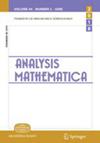The Hilbert Transform for Dunkl Differential Operators Associated to the Reflection Group ℤ2
IF 0.6
3区 数学
Q3 MATHEMATICS
引用次数: 0
Abstract
The aim of this paper is to introduce the Dunkl—Hilbert transform Hk, with k ≥ 0, induced by the Dunkl differential operator and associated with the reflection group ℤ2. For this end, we establish that the Dunkl—Poisson kernel and the conjugate Dunkl—Poisson kernel satisfy the Cauchy—Riemann equations in the Dunkl context. We prove the continuity of Hk on Lp(wk) for 1 < p < ∞, where wk(x) = ∣x∣2k. Finally, we introduce the maximal Hilbert operator H k* and establish an analogue of Cotlar’s theorem.
与反射群有关的Dunkl微分算子的Hilbert变换
本文的目的是介绍由Dunkl微分算子诱导并与反射群相关的k≥0的Dunkl-Hilbert变换Hkℤ2.为此,我们建立了Dunkl-Pisson核和共轭Dunkl-Passon核在Dunkl上下文中满足Cauchy-Riemann方程。我们证明了Hk在Lp(wk)上对于1<;p<∞,式中,wk(x)=ŞxŞ2k。最后,我们引入了最大希尔伯特算子Hk*,并建立了Cotlar定理的一个类似。
本文章由计算机程序翻译,如有差异,请以英文原文为准。
求助全文
约1分钟内获得全文
求助全文
来源期刊

Analysis Mathematica
MATHEMATICS-
CiteScore
1.00
自引率
14.30%
发文量
54
审稿时长
>12 weeks
期刊介绍:
Traditionally the emphasis of Analysis Mathematica is classical analysis, including real functions (MSC 2010: 26xx), measure and integration (28xx), functions of a complex variable (30xx), special functions (33xx), sequences, series, summability (40xx), approximations and expansions (41xx).
The scope also includes potential theory (31xx), several complex variables and analytic spaces (32xx), harmonic analysis on Euclidean spaces (42xx), abstract harmonic analysis (43xx).
The journal willingly considers papers in difference and functional equations (39xx), functional analysis (46xx), operator theory (47xx), analysis on topological groups and metric spaces, matrix analysis, discrete versions of topics in analysis, convex and geometric analysis and the interplay between geometry and analysis.
 求助内容:
求助内容: 应助结果提醒方式:
应助结果提醒方式:


